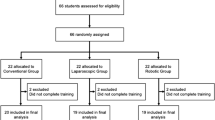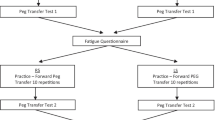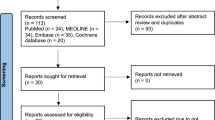Abstract
Introduction
Robotic assistance may provide for distinct technical advantages over conventional laparoscopic technique. The goals of this study were (1) to objectively evaluate the difference in the learning curves by novice and expert surgeons in performing fundamental laparoscopic skills using conventional laparoscopic surgery (CLS) and robotic-assisted laparoscopic surgery (RALS) and (2) to evaluate the surgeons’ frustration level in performing these tasks.
Methods
Twelve experienced and 31 novices in laparoscopy were prospectively evaluated in performing three standardized laparoscopic tasks in five consecutive, weekly training sessions. Analysis of the learning curves was based on the magnitude, rate, and quickness in performance improvement. The participant’s frustration and mood were also evaluated during and after every session.
Results
For the novice participants, RALS allowed for shorter time to task completion and greater accuracy. However, significant and rapid improvement in performance as measured by magnitude, rate, and quickness at each session was also seen with CLS. For the experienced surgeons, RALS only provided a slight improvement in performance. For all participants, the use of RALS was associated with less number of sessions in which they felt frustrated, less number of frustration episodes during a session, lower frustration score during and after the session, and higher good mood score.
Conclusion
The advantages of RALS may be of most benefit when doing more complex tasks and by less experienced surgeons. RALS should not be used as a replacement for CLS but rather in specific situations in which it has the greatest advantages.



Similar content being viewed by others
References
Judkins TN, Oleynikov D, Stergiou N (2009) Objective evaluation of expert and novice performance during robotic surgical training tasks. Surg Endosc 23(3):590–597
Orvieto MA, Large M, Gundeti MS (2012) Robotic paediatric urology. BJU Int 110(1):2–13
Heemskerk J, van Gemert WG, de Vries J, Greve J, Bouvy ND (2007) Learning curves of robot-assisted laparoscopic surgery compared with conventional laparoscopic surgery: an experimental study evaluating skill acquisition of robot-assisted laparoscopic tasks compared with conventional laparoscopic tasks in inexperienced users. Surg Laparos Endosc Percutan Tech 17(3):171–174
Kim HJ, Choi GS, Park JS, Park SY (2014) Comparison of surgical skills in laparoscopic and robotic tasks between experienced surgeons and novices in laparoscopic surgery: an experimental study. Ann Coloproctol 30(2):71–76
Scott DJ, Young WN, Tesfay ST, Frawley WH, Rege RV, Jones DB (2001) Laparoscopic skills training. Am J Surg 182(2):137–142
Ballantyne GH (2002) Robotic surgery, telerobotic surgery, telepresence, and telementoring. Review of early clinical results. Surg Endosc 16(10):1389–1402
Gutt CN, Oniu T, Mehrabi A, Kashfi A, Schemmer P, Buchler MW (2004) Robot-assisted abdominal surgery. Br J Surg 91(11):1390–1397
Yohannes P, Rotariu P, Pinto P, Smith AD, Lee BR (2002) Comparison of robotic versus laparoscopic skills: is there a difference in the learning curve? Urology 60(1):39–45
Dulan G, Rege RV, Hogg DC et al (2012) Developing a comprehensive, proficiency-based training program for robotic surgery. Surgery 152(3):477–488
Blavier A, Gaudissart Q, Cadiere GB, Nyssen AS (2007) Comparison of learning curves and skill transfer between classical and robotic laparoscopy according to the viewing conditions: implications for training. Am J Surg 194(1):115–121
Arora S, Tierney T, Sevdalis N et al (2010) The Imperial Stress Assessment Tool (ISAT): a feasible, reliable and valid approach to measuring stress in the operating room. World J Surg 34(8):1756–1763
McCullagh P, Nelder JA (1989) Generalized linear models, 2nd edn. Chapman and Hall, New York
Neter J, Kutner MH, Nachtsheim CJ, Wasserman W (1996) Applied linear statistical models, 4th edn. Richard D. Irwin Inc., Illinois
Stefanidis D, Wang F, Korndorffer JR Jr, Dunne JB, Scott DJ (2010) Robotic assistance improves intracorporeal suturing performance and safety in the operating room while decreasing operator workload. Surg Endosc 24(2):377–382
Chandra V, Nehra D, Parent R et al (2010) A comparison of laparoscopic and robotic assisted suturing performance by experts and novices. Surgery 147(6):830–839
Kenngott HG, Muller-Stich BP, Reiter MA, Rassweiler J, Gutt CN (2008) Robotic suturing: technique and benefit in advanced laparoscopic surgery. Minim Invasive Ther Allied Technol MITAT 17(3):160–167
Chowriappa AJ, Shi Y, Raza SJ et al (2013) Development and validation of a composite scoring system for robot-assisted surgical training: the Robotic Skills Assessment Score. J Surg Res 185(2):561–569
Vassiliou MC, Feldman LS, Andrew CG et al (2005) A global assessment tool for evaluation of intraoperative laparoscopic skills. Am J Surg 190(1):107–113
Hassan I, Weyers P, Maschuw K et al (2006) Negative stress-coping strategies among novices in surgery correlate with poor virtual laparoscopic performance. Br J Surg 93(12):1554–1559
Herrell SD, Smith JA Jr (2005) Robotic-assisted laparoscopic prostatectomy: what is the learning curve? Urology 66(5 Suppl):105–107
Gallagher AG, Richie K, McClure N, McGuigan J (2001) Objective psychomotor skills assessment of experienced, junior, and novice laparoscopists with virtual reality. World J Surg 25(11):1478–1483
Ruurda JP, Broeders IA, Simmermacher RP (2002) Borel Rinkes IH, Van Vroonhoven TJ. Feasibility of robot-assisted laparoscopic surgery: an evaluation of 35 robot-assisted laparoscopic cholecystectomies. Surgical Laparosc Endosc Percutan Techn 12(1):41–45
Conflict of interest
None of the authors had any disclosures or had any potential financial or non-financial conflicts of interest in the publication of this study.
Ethical standard
All participants provided their informed consent in order to participate in this study. All procedures performed in studies involving human participants were in accordance with the ethical standards of the institutional research committee and with the 1964 Helsinki declaration and its later amendments or comparable ethical standards.
Author information
Authors and Affiliations
Corresponding author
Additional information
The exercises performed in this study were a component of a formal training process for the RALS, and their analysis was a component of the quality improvement process for the training program.
Rights and permissions
About this article
Cite this article
Passerotti, C.C., Franco, F., Bissoli, J.C.C. et al. Comparison of the learning curves and frustration level in performing laparoscopic and robotic training skills by experts and novices. Int Urol Nephrol 47, 1075–1084 (2015). https://doi.org/10.1007/s11255-015-0991-3
Received:
Accepted:
Published:
Issue Date:
DOI: https://doi.org/10.1007/s11255-015-0991-3




